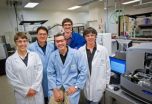(Press-News.org) CAMBRIDGE, Mass. — Much has been made of graphene's exceptional qualities, from its ability to conduct heat and electricity better than any other material to its unparalleled strength: Worked into a composite material, graphene can repel bullets better than Kevlar. Previous research has also shown that pristine graphene — a microscopic sheet of carbon atoms arranged in a honeycomb pattern — is among the most impermeable materials ever discovered, making the substance ideal as a barrier film.
But the material may not be as impenetrable as scientists have thought. By engineering relatively large membranes from single sheets of graphene grown by chemical vapor deposition, researchers from MIT, Oak Ridge National Laboratory (ORNL) and elsewhere have found that the material bears intrinsic defects, or holes in its atom-sized armor. In experiments, the researchers found that small molecules like salts passed easily through a graphene membrane's tiny pores, while larger molecules were unable to penetrate.
The results, the researchers say, point not to a flaw in graphene, but to the possibility of promising applications, such as membranes that filter microscopic contaminants from water, or that separate specific types of molecules from biological samples.
"No one has looked for holes in graphene before," says Rohit Karnik, associate professor of mechanical engineering at MIT. "There's a lot of chemical methods that can be used to modify these pores, so it's a platform technology for a new class of membranes."
Karnik and his colleagues, including researchers from the Indian Institute of Technology and King Fahd University of Petroleum and Minerals, have published their results in the journal ACS Nano.
Karnik worked with MIT graduate student Sean O'Hern to look for materials "that could lead to not just incremental changes, but substantial leaps in terms of the way membranes perform." In particular, the team cast around for materials with two key attributes, high flux and tunability: that is, membranes that quickly filter fluids, but are also easily tailored to let certain molecules through while trapping others. The group settled on graphene, in part because of its extremely thin structure and its strength: A sheet of graphene is as thin as a single atom, but strong enough to let high volumes of fluids through without shredding apart.
The team set out to engineer a membrane spanning 25 square millimeters — a surface area that is large by graphene standards, holding about a quadrillion carbon atoms. They used graphene synthesized by chemical vapor deposition, borrowing on expertise from the research group of Jing Kong, the ITT Career Development Associate Professor of Electrical Engineering at MIT. The team then developed techniques to transfer the graphene sheet to a polycarbonate substrate dotted with holes.
Once the researchers successfully transferred the graphene, they began to experiment with the resulting membrane, exposing it to flowing water containing molecules of varying sizes. They theorized that if graphene were indeed impermeable, the molecules would be blocked from flowing across. However, experiments showed otherwise, as researchers observed salts flowing through the membrane.
As another test, the team exposed a copper foil with graphene grown on it to a chemical agent that dissolves copper. Instead of protecting the metal, graphene let the agent through, corroding the underlying copper. To test the size of the pores within graphene, the group attempted to filter water with larger molecules. It appeared that there was a limit to the size of the pores, as larger molecules were unable to pass through the membrane.
As a final experiment, Karnik and O'Hern observed the actual holes in the graphene membrane, looking at the material through a high-powered electron microscope at ORNL in collaboration with Juan-Carlos Idrobo. They found that pores ranged in size from about 1 to 12 nanometers — just wide enough to selectively let some small molecules through.
"Right now we know from this characterization how the graphene behaves, and what kind of intrinsic pores it has," Karnik says. "In some sense it's the first step to practically realizing graphene-based membranes."
Karnik adds that a near-term application for such membranes may include a portable sensor in which a layer of graphene "could shield the sensor from the environment," letting through only a molecule or contaminant of interest. Another use may be in drug delivery, with graphene, dotted with pores of a determined size, delivering therapies in a controlled release.
"We're right now in the process of transferring more graphene to different substrates and making holes of our own, making a viable membrane for water filtration," O'Hern says.
###Other researchers involved in the work are Cameron Stewart, Michael Boutilier, Sreekar Bhaviripudi, Sarit Das, Tahar Laoui and Muataz Atieh. This work was funded by the King Fahd University of Petroleum and Minerals through the Center for Clean Water and Clean Energy at MIT and KFUPM, and was also supported by the ORNL ShaRE program.
Written by: Jennifer Chu, MIT News Office
Tiny pores in graphene could give rise to membranes
New membranes may filter water or separate biological samples
2012-10-23
ELSE PRESS RELEASES FROM THIS DATE:
Are schizophrenia and autism close relations?
2012-10-23
Autism Spectrum Disorders (ASD), a category that includes autism, Asperger Syndrome, and Pervasive Developmental Disorder, are characterized by difficulty with social interaction and communication, or repetitive behaviors. The U.S. Centers for Disease Control and Management says that one in 88 children in the US is somewhere on the Autism spectrum — an alarming ten-fold increase in the last four decades.
New research by Dr. Mark Weiser of Tel Aviv University's Sackler Faculty of Medicine and the Sheba Medical Center has revealed that ASD appears share a root cause with ...
NASA sees active region on the sun emit another flare
2012-10-23
VIDEO:
Video of the Oct. 22, 2012, solar flare as captured by NASA's Solar Dynamics Observatory in the 131 and 304 Angstrom wavelengths. LINK TO HIGHEST RESOLUTION VIDEO: ...
Quasar may be embedded in unusually dusty galaxy
2012-10-23
Hubble astronomers have looked at one of the most distant and brightest quasars in the universe and are surprised by what they did not see: the underlying host galaxy of stars feeding the quasar. The best explanation is that the galaxy is shrouded in so much dust that the stars are completely hidden everywhere. Astronomers believe that the James Webb Space Telescope will reveal the galaxy.
All but the very first galaxies contain some dust—the early universe was dust-free until the first generation of stars started making dust through nuclear fusion. As these stars aged ...
Is declining medical imaging use driving up hospital stays and medical costs?
2012-10-23
A new report by the Harvey L. Neiman Health Policy Institute shows that the length of the average hospital stay in the United States has increased at the same time as use of medical imaging scans has declined. It is unclear if the trends are related, but potentially important, as hospital admissions are among the largest, and fastest growing, health care costs. More research is needed to assess the potential negative impact of government and private insurer imaging reductions on overall medical costs and patient safety.
"Lawmakers, regulators and medical professionals ...
Making transport a driver for development in Africa
2012-10-23
A new report by a panel of international experts highlights policies to improve air quality road safety and congestion, supporting African development.
Transport is playing a big role in delivering economic development to Africa. But as the demand for transport grows and cities expand, policy makers need to tackle transport challenges to make sure that all parts of society can benefit from this central driver of jobs and growth.
"Transport policies in Africa are of critical importance to the delivery of sustainable cities, healthy citizens and poverty eradication," ...
Training your robot the PaR-PaR way
2012-10-23
Teaching a robot a new trick is a challenge. You can't reward it with treats and it doesn't respond to approval or disappointment in your voice. For researchers in the biological sciences, however, the future training of robots has been made much easier thanks to a new program called "PaR-PaR."
Nathan Hillson, a biochemist at the U.S. Department of Energy (DOE)'s Joint BioEnergy Institute (JBEI), led the development of PaR-PaR, which stands for Programming a Robot. PaR-PaR is a simple high-level, biology-friendly, robot-programming language that allows researchers to ...
Study explains connection between Hawaii's dueling volcanoes
2012-10-23
HOUSTON -- (Oct. 23, 2012) -- A new Rice University-led study finds that a deep connection about 50 miles underground can explain the enigmatic behavior of two of Earth's most notable volcanoes, Hawaii's Mauna Loa and Kilauea. The study, the first to model paired volcano interactions, explains how a link in Earth's upper mantle could account for Kilauea and Mauna Loa's competition for the same deep magma supply and their simultaneous "inflation," or bulging upward, during the past decade.
The study appears in the November issue of Nature Geoscience.
The research offers ...
Oxygen's ups and downs in the early atmosphere and ocean
2012-10-23
RIVERSIDE, Calif. — Most researchers imagine the initial oxygenation of the ocean and atmosphere to have been something like a staircase, but with steps only going up. The first step, so the story goes, occurred around 2.4 billion years ago, and this, the so-called Great Oxidation Event, has obvious implications for the origins and evolution of the first forms of eukaryotic life. The second big step in this assumed irreversible rise occurred almost two billion years later, coinciding with the first appearances and earliest diversification of animals.
Now a team led ...
Don't be so fast to judge a cat by its color, new study warns
2012-10-23
Just like humans, domestic cats are often judged by their color, and the media and folklore help perpetuate these stereotypes. Take the snobbish, aloof, white kitty who promotes "Fancy Feast," and spooky images of black cats, which can be associated with bad luck and witches, especially around Halloween.
Interested in the link between how cat color influences adoption rates, a University of California, Berkeley, researcher surveyed 189 people with experience of cats as pets and found that they were more likely to assign positive personality traits to orange cats and less ...
Influence in times of crisis: How do men and women evaluate precarious leadership positions?
2012-10-23
We've all heard of the "glass ceiling" but the recent economic crisis has illuminated another workplace phenomenon: the "glass cliff." Women seem to be overrepresented in precarious leadership positions at organizations going through crisis. Evidence is growing that more feminine leadership traits, such as being understanding and tactful, are believed to be desirable under such circumstances, causing people to make a "think crisis – think female" association.
But is it that women are always passively selected into these jobs or do they sometimes also actively seek them ...
LAST 30 PRESS RELEASES:
Support for parents with infants at pediatric check-ups leads to better reading and math skills in elementary school
Kids’ behavioral health is a growing share of family health costs
Day & night: Cancer disrupts the brain’s natural rhythm
COVID-19 vaccination significantly reduces risk to pregnant women and baby
The role of vaccination in maternal and perinatal outcomes associated with COVID-19 in pregnancy
Mayo Clinic smartwatch system helps parents shorten and defuse children's severe tantrums early
Behavioral health spending spikes to 40% of all children’s health expenditures, nearly doubling in a decade
Digital cognitive behavioral treatment for generalized anxiety disorder
Expenditures for pediatric behavioral health care over time and estimated family financial burden
Air conditioning in nursing homes and mortality during extreme heat
The Alps to lose a record number of glaciers in the next decade
What makes a good proton conductor?
New science reporting guide published for journalists in Bulgaria
New international study reveals major survival gaps among children with cancer
New science reporting guide published for journalists in Turkey
Scientists develop a smarter mRNA therapy that knows which cells to target
Neuroanatomy-informed brain–machine hybrid intelligence for robust acoustic target detection
Eight SwRI hydrogen projects funded by ENERGYWERX
The Lundquist Institute and its start-up company Vitalex Biosciences Announces Strategic Advancement of Second-Generation fungal Vaccine VXV-01 through Phase 1 Trials under $40 Million Competitive Con
Fine particles in pollution are associated with early signs of autoimmune disease
Review article | Towards a Global Ground-Based Earth Observatory (GGBEO): Leveraging existing systems and networks
Penn and UMich create world’s smallest programmable, autonomous robots
Cleveland researchers launch first major study to address ‘hidden performance killer’ in athletes
To connect across politics, try saying what you oppose
Modulating key interaction prevents virus from entering cells
Project explores barriers to NHS career progression facing international medical graduates
Jeonbuk National University researchers explore the impact of different seasonings on the flavor perception of Doenjang soup
Two Keck Medicine of USC Hospitals named Leapfrog Top Teaching Hospitals
World-first discovery uncovers how glioblastoma tumours dodge chemotherapy, potentially opening the door to new treatments
A fatal mix-up: How certain gut bacteria drive multiple sclerosis
[Press-News.org] Tiny pores in graphene could give rise to membranesNew membranes may filter water or separate biological samples




